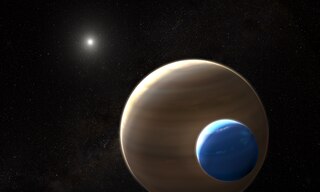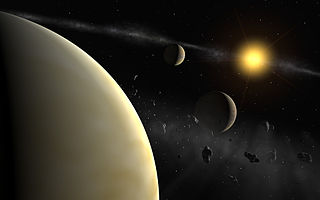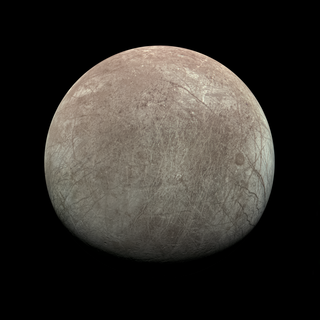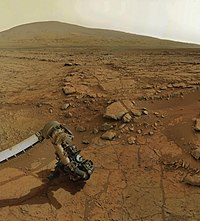
An exoplanet or extrasolar planet is a planet outside the Solar System. The first possible evidence of an exoplanet was noted in 1917 but was not then recognized as such. The first confirmation of the detection occurred in 1992. A different planet, first detected in 1988, was confirmed in 2003. As of 1 April 2024, there are 5,653 confirmed exoplanets in 4,161 planetary systems, with 896 systems having more than one planet. The James Webb Space Telescope (JWST) is expected to discover more exoplanets, and to give more insight into their traits, such as their composition, environmental conditions, and potential for life.

A planetary system is a set of gravitationally bound non-stellar objects in or out of orbit around a star or star system. Generally speaking, systems with one or more planets constitute a planetary system, although such systems may also consist of bodies such as dwarf planets, asteroids, natural satellites, meteoroids, comets, planetesimals and circumstellar disks. The Sun together with the planetary system revolving around it, including Earth, forms the Solar System. The term exoplanetary system is sometimes used in reference to other planetary systems.

In astronomy and astrobiology, the habitable zone (HZ), or more precisely the circumstellar habitable zone (CHZ), is the range of orbits around a star within which a planetary surface can support liquid water given sufficient atmospheric pressure. The bounds of the HZ are based on Earth's position in the Solar System and the amount of radiant energy it receives from the Sun. Due to the importance of liquid water to Earth's biosphere, the nature of the HZ and the objects within it may be instrumental in determining the scope and distribution of planets capable of supporting Earth-like extraterrestrial life and intelligence.

An exomoon or extrasolar moon is a natural satellite that orbits an exoplanet or other non-stellar extrasolar body.

Planetary habitability is the measure of a planet's or a natural satellite's potential to develop and maintain environments hospitable to life. Life may be generated directly on a planet or satellite endogenously or be transferred to it from another body, through a hypothetical process known as panspermia. Environments do not need to contain life to be considered habitable nor are accepted habitable zones (HZ) the only areas in which life might arise.

The following outline is provided as an overview of and topical guide to astronomy:

HD 69830 d is an exoplanet likely orbiting within the habitable zone of the star HD 69830, the outermost of three such planets discovered in the system. It is located approximately 40.7 light-years (12.49 parsecs, or 3.8505×1014 km) from Earth in the constellation of Puppis. The exoplanet was found by using the radial velocity method, from radial-velocity measurements via observation of Doppler shifts in the spectrum of the planet's parent star.

Gliese 581c is an exoplanet orbiting within the Gliese 581 system. It is the second planet discovered in the system and the third in order from the star. With a mass at least 5.5 times that of the Earth, it is classified as a super-Earth.

Gliese 581d is a doubtful, and frequently disputed, exoplanet candidate orbiting within the Gliese 581 system, approximately 20.4 light-years away in the Libra constellation. It was the third planet claimed in the system and the fourth or fifth in order from the star. Multiple subsequent studies found that the planetary signal in fact originates from stellar activity, and thus the planet does not exist, but this remains disputed.

A Super-Earth is a type of exoplanet with a mass higher than Earth's, but substantially below those of the Solar System's ice giants, Uranus and Neptune, which are 14.5 and 17 times Earth's, respectively. The term "super-Earth" refers only to the mass of the planet, and so does not imply anything about the surface conditions or habitability. The alternative term "gas dwarfs" may be more accurate for those at the higher end of the mass scale, although "mini-Neptunes" is a more common term.

The habitability of natural satellites is the potential of moons to provide habitats for life, though it is not an indicator that they harbor it. Natural satellites are expected to outnumber planets by a large margin and the study of their habitability is therefore important to astrobiology and the search for extraterrestrial life. There are, nevertheless, significant environmental variables specific to moons.

An exoplanet is a planet located outside the Solar System. The first evidence of an exoplanet was noted as early as 1917, but was not recognized as such until 2016; no planet discovery has yet come from that evidence. What turned out to be the first detection of an exoplanet was published among a list of possible candidates in 1988, though not confirmed until 2003. The first confirmed detection came in 1992, with the discovery of terrestrial-mass planets orbiting the pulsar PSR B1257+12. The first confirmation of an exoplanet orbiting a main-sequence star was made in 1995, when a giant planet was found in a four-day orbit around the nearby star 51 Pegasi. Some exoplanets have been imaged directly by telescopes, but the vast majority have been detected through indirect methods, such as the transit method and the radial-velocity method. As of 1 April 2024, there are 5,653 confirmed exoplanets in 4,161 planetary systems, with 896 systems having more than one planet. This is a list of the most notable discoveries.

K-type main-sequence stars, also known as orange dwarfs, may be candidates for supporting extraterrestrial life. These stars are known as "Goldilocks stars" as they emit enough radiation in the non-UV ray spectrum to provide a temperature that allows liquid water to exist on the surface of a planet; they also remain stable in the main sequence longer than the Sun by burning their hydrogen slower, allowing more time for life to form on a planet around a K-type main-sequence star. The planet's habitable zone, ranging from 0.1–0.4 to 0.3–1.3 astronomical units (AU), depending on the size of the star, is often far enough from the star so as not to be tidally locked to the star, and to have a sufficiently low solar flare activity not to be lethal to life. In comparison, red dwarf stars have too much solar activity and quickly tidally lock the planets in their habitable zones, making them less suitable for life. The odds of complex life arising may be better on planets around K-type main-sequence stars than around Sun-like stars, given the suitable temperature and extra time available for it to evolve. Some planets around K-type main-sequence stars are potential candidates for extraterrestrial life.
HIP 57050, or GJ 1148, is a faint star with two orbiting exoplanets in the northern constellation of Ursa Major. Other designations for this star include LHS 2443, G 122-40, and Ross 1003. From a distance of 36 light years based on parallax measurements, it is drifting closer to the Sun with a radial velocity of -9 km/s. This is a faint star with an absolute magnitude of 11.64. At the distance of HIP 57050, the apparent visual magnitude is 11.86, which is much too faint to be seen with the naked eye. HD 164595 has a high proper motion, traversing the celestial sphere at an angular rate of 0.577″ yr−1.

The theorized habitability of red dwarf systems is determined by a large number of factors. Modern evidence indicates that planets in red dwarf systems are unlikely to be habitable, due to their low stellar flux, high probability of tidal locking and thus likely lack of magnetospheres and atmospheres, small circumstellar habitable zones and the high stellar variation experienced by planets of red dwarf stars. However, the sheer numbers and longevity of red dwarfs could provide ample opportunity to realize any small possibility of habitability.
HIP 57274 d is an exoplanet orbiting the K-type main sequence star HIP 57274 about 84.5 light-years (26 parsecs, or nearly 8.022×1016 km) from Earth in the constellation Cetus. It orbits within the outer part of its star's habitable zone, at a distance of 1.01 AU. The exoplanet was found by using the radial velocity method, from radial-velocity measurements via observation of Doppler shifts in the spectrum of the planet's parent star.

TRAPPIST-1e, also designated as 2MASS J23062928-0502285 e, is a rocky, close-to-Earth-sized exoplanet orbiting within the habitable zone around the ultracool dwarf star TRAPPIST-1, located 40.7 light-years away from Earth in the constellation of Aquarius. Astronomers used the transit method to find the exoplanet, a method that measures the dimming of a star when a planet crosses in front of it.

Ross 128 b is a confirmed Earth-sized exoplanet, likely rocky, that is orbiting within the inner habitable zone of the red dwarf star Ross 128, at a distance of around 11 light-years from Earth. The exoplanet was found using a decade's worth of radial velocity data using the European Southern Observatory's HARPS spectrograph at the La Silla Observatory in Chile. Ross 128 b is the nearest exoplanet around a quiet red dwarf, and is considered one of the best candidates for habitability. The planet is only 35% more massive than Earth, receives only 38% more starlight, and is expected to be a temperature suitable for liquid water to exist on the surface, if it has an atmosphere.

Teegarden's Star b is an exoplanet found orbiting within the habitable zone of Teegarden's Star, an M-type red dwarf 12.5 light years away from the Solar System. It had the highest Earth Similarity Index (ESI) of any exoplanet, but in February 2024 a new study updated the parameters of the planet, thus reducing its ESI to 0.90, making it no longer the planet with the hightest ESI. Along with Teegarden's Star c, it is among the closest known potentially habitable exoplanets.

Pulsar planets are planets that are orbiting pulsars. The first such planets to be discovered were around a millisecond pulsar in 1992 and were the first extrasolar planets to be confirmed as discovered. Pulsars are extremely precise clocks and even small planets can create detectable variations in pulsar traits; the smallest known exoplanet is a pulsar planet.




















